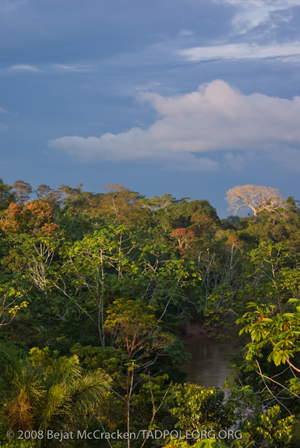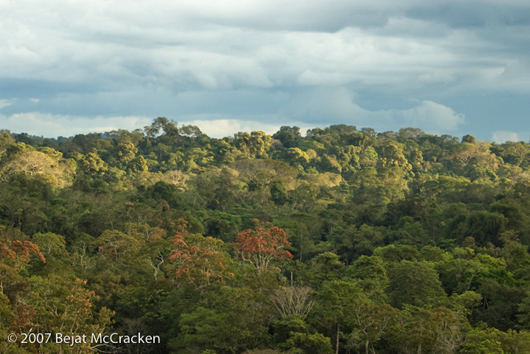Ecuador: Yasuni - the most biodiverse place on Earth?
22.01.10
A study published in the open access journal Plos One has revealed extraordinary species richness in the western Amazon covering eastern Ecuador and northern Peru.
By combining existing data from vascular plants, amphibians, birds, and mammals and mapping it over each other it was discovered that Yasuni National Park is the only protected area within the boundaries of this mega-diversity overlap. Covering just 14% of the land area in the overlap the protected area is dwarfed in size by active or proposed oil concessions which total a massive 79%.
Yasuni National Park in the northwest Amazon is potentially one of the most biodiverse areas on the planet. However, it is in the unfortunate position of sitting on top of one of Ecuador's biggest oil reserves.
Dr Peter English from the team asserts that “Yasuni is the most diverse area in South America, and possibly the world. Amphibians, birds, mammals, and vascular plants all reach maximum diversity in Yasuni.”
This landscape is part of a vast stretch of wilderness, and the figures the team of scientists revealed were staggering. Yasuni appears to protect the richest area in the world for woody plant species: per hectare there are approximately 655 tree species and this figure rises to 1,100 for 25 hectares. In total there appear to be about 900 species of vascular plants per hectare placing it within the top nine richest global centres.
Species richness data from across the northern Amazon region for four groups was analysed. These maps were then laid over each other to discover the areas of highest biodiversity or "quadruple richness areas" as the report describes them.
The richness centre overlap of the four key groups studied (amphibians, birds, mammals, and vascular plants) combined in the areas marked red on the map.
The only well protected area found within this overlap landed on Yasuni National Park in Ecuador.
But the report stresses this richness is not confined to Yasuni. The whole of the Amazon basin is rich in tree species and the report confirms that the richest belt runs east-west along the equator from Yasuni to Manaus. More studies are needed to confirm exactly where the highest areas of diversity lies according to the authors.
Despite its extreme wilderness, apparently you can walk for thousands of kilometres without encountering a road, Yasuni is home to many plants that are globally threatened – including the tree Rollinia helosiodes (critically endangered according to IUCN) – and their prospects may be uncertain. Unfortunately, these ancient trees sit on top of a huge oil reserve and it is this potential mineral wealth that poses the greatest threat to this wealth of nature. Oil is very important to Ecuador as it makes up half their export earnings and over one-third of its federal budget.

An open ridge overlooking the rainforest and the Tiputini River that boarders Yasuni National Park. Located in the Ecuadorian Amazon, Yasuni National Park is an UNESCO Biosphere Reserve and World Heritage Site.
© Bejat McCracken
There are two major oil reserves within Yasuni: known as the ITT Block and Block 31. ITT Block is estimated to contain 850 million barrels of crude oil, or 20% of Ecuador’s known reserves and the neighbouring Block 31 could share any infrastructure development. But in 2007 in a piece of radical thinking President Correa announced he would postpone ITT drilling and seek an alternative future and in the process remove the prospect of the $7 billion potential. He, instead, proposed something known as the Yasuni-ITT initiative to generate financial wealth and, importantly, keep the oil underground.
It is argued the Yasuni-ITT Initiative would generate even more financial wealth than the oil. The forests would be kept intact, generating benefits through maintenance of forest carbon, ecosystem services, and biodiversity. The carbon monies that it would receive from the Initiative could then be invested in Yasuni and the rest of Ecuador’s protected areas.
We are entering a new age of how we value nature, but ultimately economics still play the Lion’s share in decision making processes. It remains in the balance if funding can be garnered for this ambitious project, and as a sobering reminder of what’s at stake the team state, “if the worlds most diverse forests cannot be protected in Yasuni, it seems unlikely that they can be protected anywhere else.”

Yasuni rainforest canopy. The Ecuador government has a plan to keep the oil underground -called the ITT Initiative - and keep the trees standing, but much of the land could be auctioned at any time for oil exploration. The case of Yasuni represents a battle of political and economic wills that will no doubt shape much of the conservation challenges of the 21st century.
© Bejat McCracken
Five policy recommendations from the report:
- Permit no new roads not other transportation access routes
- Permit no new oil exploration or development projects in Yasuni
- Create protected biological corridors from Yasuni to nearby Andean peaks
- Create a system of strict protected areas
- Establish a protected corridor between Yasuni and Cuyabeno Wildlife Reserve
The full report is available online from Plos ONE.
Related links:
Save America's Forests are running a campaign to help save Yasuni.
19.01.10
 Greg Farrington, Executive Director of the California Academy of Sciences, recently visited the vast island of Madagascar with some of his team of researchers. He was kind enough to share some of his beautiful images of the extraordinary landscapes, plants, and people (and in a break from tradition, some animals too!) with Plant Talk.
Greg Farrington, Executive Director of the California Academy of Sciences, recently visited the vast island of Madagascar with some of his team of researchers. He was kind enough to share some of his beautiful images of the extraordinary landscapes, plants, and people (and in a break from tradition, some animals too!) with Plant Talk.
Copenhagen: Nature has the solutions
07.12.09
 On the opening days of the Copenhagen Climate Conference there has been a call from IUCN urging leaders meeting in Copenhagen to include nature’s solutions to reduce emissions and cope with impacts of climate change in a post-2012 deal.
On the opening days of the Copenhagen Climate Conference there has been a call from IUCN urging leaders meeting in Copenhagen to include nature’s solutions to reduce emissions and cope with impacts of climate change in a post-2012 deal.
Ecuador: World's smallest orchid discovered
01.12.09
The world's smallest orchid has been discovered in Ecuador and, remarkably, the petals are so thin they're just one cell thick.
Amazon: Deforestation rate drops
24.11.09
 Deforestation in the Amazon is at its lowest rate for 20 years according to the latest data from the Brazilian government. Only - and it is a painful only - 7,000 square kilometres of forest was destroyed or damaged in the year August 2008 to July 2009.
Deforestation in the Amazon is at its lowest rate for 20 years according to the latest data from the Brazilian government. Only - and it is a painful only - 7,000 square kilometres of forest was destroyed or damaged in the year August 2008 to July 2009.